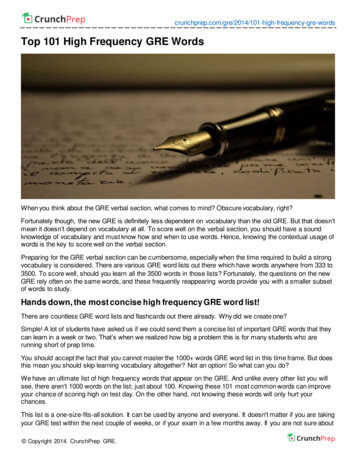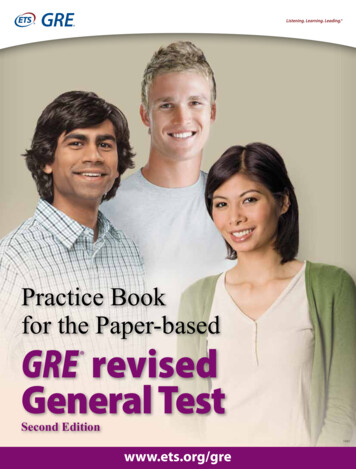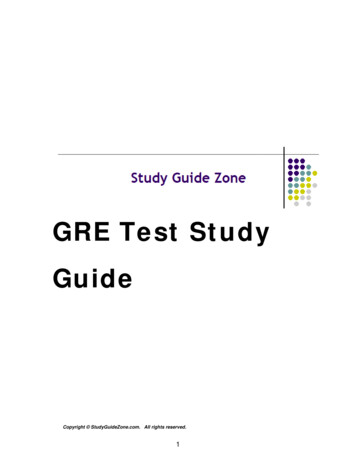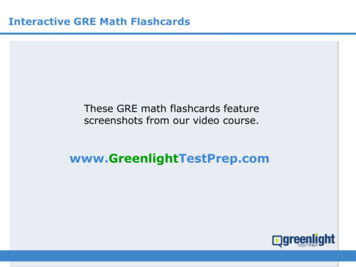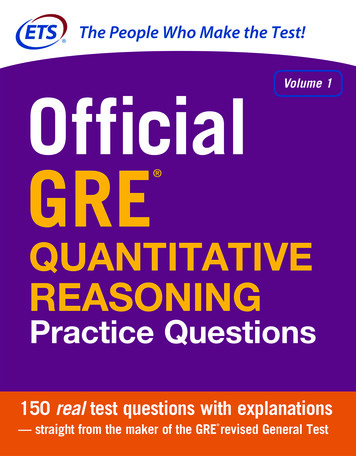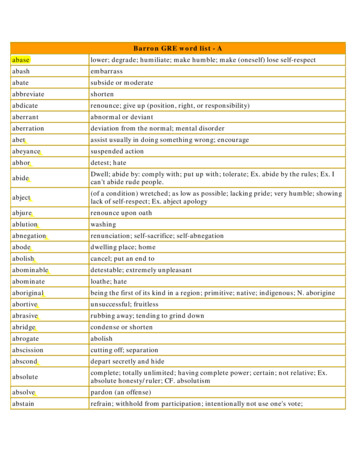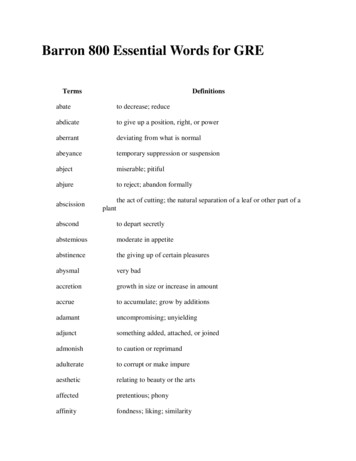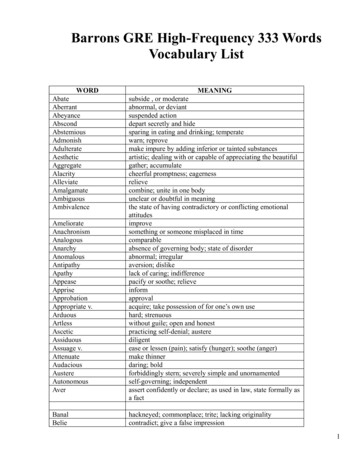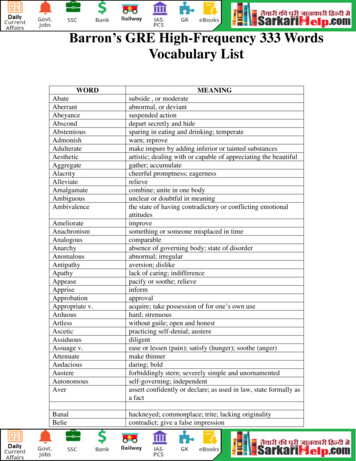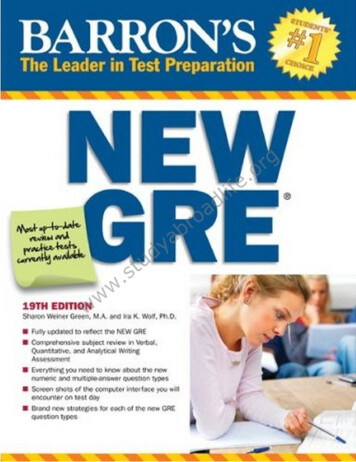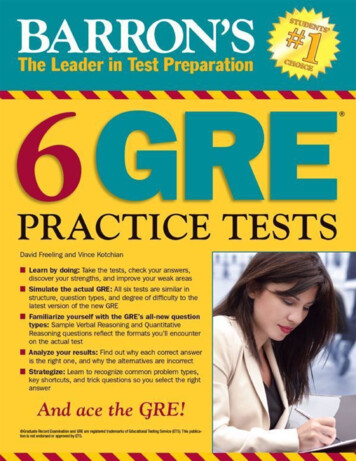
Transcription
About the AuthorsDavid Freeling is the founder and director of Insight Tutoring (of San Francisco) and has helpedthousands of children and adults improve their basic math and English skills. He has taught classesfor the GRE, SAT, and SSAT exams. Mr. Freeling is the author of Barron’s 6 GRE Practice Testsand Barron’s GRE Math Workbook, 2nd Edition, as well as the self-published First Fun SAT Book.He offers a free online library of test-prep videos at www.NoeValleyTutor.com. His most recent bookand accompanying website VocabMonster.com are scheduled for an Autumn 2012 launch. Mr.Freeling received a BA in mathematics from Columbia University and completed one year ofgraduate studies in math at Columbia.Vince Kotchian grew up in Connecticut and completed the honors program at Boston College,graduating with a B.A. in English Literature. He has been privately tutoring standardized tests in SanDiego for the past several years, and has helped hundreds of students get into the schools of theirchoice. He has authored nationally-published books on the SSAT/ISEE and GRE, he teaches a GREprep course at UCSD, and he has an official 169V 166Q score on the new GRE. When he’s notworking, Vince enjoys playing and watching sports, reading and writing fiction, and running (which isenjoyable at least some of the time).
Copyright 2012 by Barron’s Educational Series, Inc.All rights reserved.No part of this work may be reproduced or distributed in any form or by any meanswithout the written permission of the copyright owner.All inquiries should be addressed to:Barron’s Educational Series, Inc.250 Wireless BoulevardHauppauge, NY 11788www.barronseduc.come-ISBN: 978-1-4380-8373-5First e-Book Publication: August, 2012
ContentsAcknowledgmentsIntroductionOverview of the GREHow Is the GRE Scored?A Closer Look at GRE Verbal ReasoningA Closer Look at GRE Quantitative ReasoningBasic Test-Taking Strategies for the GRETips for Taking a Computer-Based ExamGuessing StrategiesPractice Test 1Section 1—Analytical WritingSection 2—Verbal ReasoningSection 3—Quantitative ReasoningSection 4—Verbal ReasoningSection 5—Quantitative ReasoningAnswer KeyAnswer ExplanationsPractice Test 2Section 1—Analytical WritingSection 2—Verbal ReasoningSection 3—Quantitative ReasoningSection 4—Verbal ReasoningSection 5—Quantitative ReasoningAnswer KeyAnswer ExplanationsPractice Test 3Section 1—Analytical WritingSection 2—Verbal ReasoningSection 3—Quantitative ReasoningSection 4—Verbal ReasoningSection 5—Quantitative ReasoningAnswer KeyAnswer ExplanationsPractice Test 4Section 1—Analytical WritingSection 2—Verbal Reasoning
Section 3—Quantitative ReasoningSection 4—Verbal ReasoningSection 5—Quantitative ReasoningAnswer KeyAnswer ExplanationsPractice Test 5Section 1—Analytical WritingSection 2—Verbal ReasoningSection 3—Quantitative ReasoningSection 4—Verbal ReasoningSection 5—Quantitative ReasoningAnswer KeyAnswer ExplanationsPractice Test 6Section 1—Analytical WritingSection 2—Verbal ReasoningSection 3—Quantitative ReasoningSection 4—Verbal ReasoningSection 5—Quantitative ReasoningAnswer KeyAnswer Explanations
AcknowledgmentsINTRODUCTIONExcerpt from Thilo Hinterberger: “The Sensorium: A Multimodel Neurofeedback Environment,”Advances in Human-Computer Interaction, vol. 2011, Article ID 724204, 10 pages, 2011.doi:10.1155/2011/724204.PRACTICE TEST 1Excerpt from Michael J. Pauers, “One Fish, Two Fish, Red Fish, Blue Fish: Geography, Ecology,Sympatry, and Male Coloration in the Lake Malawi Cichlid Genus Labeotropheus (Perciformes:Cichlidae),” International Journal of Evolutionary Biology, vol. 2011, Article ID 575469, 12pages, 2011. doi:10.4061/2011/575469.Excerpt from Karen E. H. Skinazi, “A Cosmopolitan New World: Douglas Coupland’s Canadianationof AmLit,” AmeriQuests, vol. 4, no. 1, 2007.Excerpt from Ron Coleman, “Long Memory of Pathfinding Aesthetics,” International Journal ofComputer Games Technology , vol. 2009, Article ID 318505, 9 pages, 2009.doi:10.1155/2009/318505.Excerpt from Katherine Garrett and Gintaras Dūda, “Dark Matter: A Primer,” Advances inAstronomy, vol. 2011, Article ID 968283, 22 pages, 2011. doi:10.1155/2011/968283.Excerpt from Christine Photinos, “The Tramp in American Literature, 1873-1939,” AmeriQuests, vol.5, no 1, 2008.Excerpt from Frank van der Velde, “Where Artificial Intelligence and Neuroscience Meet: TheSearch for Grounded Architectures of Cognition,” Advances in Artificial Intelligence, vol. 2010,Article ID 918062, 18 pages, 2010. doi:10.1155/2010/918062.Excerpt from Dana A. Williams, “Review of A Killing in This Town,” Ameri-Quests, vol. 6, no 1,2008.PRACTICE TEST 2Excerpt from Robert D. Young, Bertrand Desjardins, Kirsten McLaughlin, Michel Poulain, andThomas T. Perls, “Typologies of Extreme Longevity Myths,” Current Gerontology and GeriatricsResearch, vol. 2010, Article ID 423087, 12 pages, 2010. doi:10.1155/2010/423087.Excerpt from Daniel Berrar, Naoyuki Sato, and Alfons Schuster, “Quo Vadis, ArtificialIntelligence?,” Advances in Artificial Intelligence, vol. 2010, Article ID 629869, 12 pages, 2010.doi:10.1155/2010/629869.
Excerpt from Bala Ramasamy and Matthew Yeung, “Customer Satisfaction and the ConsumptionFunction,” Economics Research International, vol. 2010, Article ID 202014, 5 pages, 2010.doi:10.1155/2010/202014.Excerpt from Philip McVeigh, Colin O’Dowd, and Harald Berresheim, “Eddy CorrelationMeasurements of Ozone Fluxes over Coastal Waters West of Ireland,” Advances in Meteorology,vol. 2010, Article ID 754941, 7 pages, 2010. doi:10.1155/2010/754941.Excerpt from Vedat Sar, “Epidemiology of Dissociative Disorders: An Overview,” EpidemiologyResearch International, vol. 2011, Article ID 404538, 8 pages, 2011. doi:10.1155/2011/404538.Excerpt from Sue Marasco, “Many Identities, One Nation: The Revolution and Its Legacy in the MidAtlantic,” AmeriQuests, vol. 5, no. 1, 2008, Vanderbilt University.Excerpt from Alan Lightman, AmeriQuests, vol. 3, no. 2, 2006.Excerpt from Danielle I. Harrow, Jill M. Felker, and Katherine H. Baker, “Impacts of Triclosan inGreywater on Soil Microorganisms,” Applied and Environmental Soil Science, vol. 2011, Article ID646750, 8 pages, 2011. doi:10.1155/2011/646750.Excerpt from L. Joe Moffitt, John K. Stranlund, and Craig D. Osteen, “Securing the Border fromInvasives: Robust Inspections Under Severe Uncertainty,” Economics Research International, vol.2010, Article ID 510127, 9 pages, 2010. doi:10.1155/2010/510127.PRACTICE TEST 3Excerpt from Som B. Ale and Henry F. Howe, “What Do Ecological Paradigms Offer toConservation?,” International Journal of Ecology, vol. 2010, Article ID 250754, 9 pages, 2010.doi:10.1155/2010/250754.Excerpt from Paul Hegarty, “The Hallucinatory Life of Tape,” Culture Machine, vol. 9, 2007, ISSN1465–4121.Excerpt from Trevor Paglen, “Unmarked Planes and Hidden Geographies,” Vectors Journal.Excerpt from Niv Horesh, “The People’s or the World’s: RMB Internationalisation in LongerHistoric Perspective,” Economics Research International, vol. 2011, Article ID 161074, 13 pages,2011. doi:10.1155/2011/161074.PRACTICE TEST 4Excerpt from Robert G. Mogull, “A Contrast of U.S. Metropolitan Demographic Poverty: Chicago,Los Angeles, and New York,” International Journal of Population Research, vol. 2011, Article ID860684, 5 pages, 2011. doi:10.1155/2011/860684.
Excerpt from Marc Ebner and Stuart Hameroff, “Lateral Information Processing by Spiking Neurons:A Theoretical Model of the Neural Correlate of Consciousness,” Computational Intelligence andNeuroscience, vol. 2011, Article ID 247879, 17 pages, 2011. doi:10.1155/2011/247879.Excerpt from Mark Poster, The Aesthetics of Distracting Media, Culture Machine, vol. 4, 2002.Excerpt from Dave Boothroyd, Deconstruction and Everyday Life, or How Deconstruction HelpedMe Quit Smoking, Culture Machine, vol. 6, 2004.Excerpt from Gillian Fuller, Perfect Match: Biometrics and Body Patterning in a Networked World,The Fibreculture Journal, Issue 1, 2003.Excerpt from Lisa Gye, Halflives, a Mystory: Writing Hypertext to Learn, The Fibreculture Journal ,Issue 2, 2003.PRACTICE TEST 5Excerpt from Molly Oshun, Nicole M. Ardoin, and Sharon Ryan, “Use of the Planning OutreachLiaison Model in the Neighborhood Planning Process: A Case Study in Seattle’s Rainier ValleyNeighborhood,” Urban Studies Research, vol. 2011, Article ID 687834, 12 pages, 2011.doi:10.1155/2011/ 687834.Excerpt from Douglas S. Massey and María Aysa-Lastra, “Social Capital and International Migrationfrom Latin America,” International Journal of Population Research, vol. 2011, Article ID 834145,18 pages, 2011. doi:10.1155/2011/ 834145.Excerpt from Beth Willman, “In Pursuit of the Least Luminous Galaxies,” Advances in Astronomy,vol. 2010, Article ID 285454, 11 pages, 2010. doi:10.1155/2010/285454.Excerpt from Peter Ruppert, “The Perils and Possibilities of Story, on Alexander Graf The Cinema ofWim Wenders: The Celluloid Highway,” Film-Philosophy, Vol. 8, No. 1 (2004).Excerpt from Mark E. Kann, “From Participatory to Digital Democracy,” Fast Capitalism (2005).Excerpt from Carl Boggs, “Corporate Power, Ecological Crisis, and Animal Rights,” FastCapitalism (2007).PRACTICE TEST 6Excerpt from Steven P. Dandaneau, “The Power Elite at 50: Wright Mills’s Political Sociology inMidlife Crisis,” Fast Capitalism (2006).Excerpt from V. Spiridonov, Z. Dimitrovski, and M. Curic, “A Three-Dimensional Simulation ofSupercell Convective Storm,” Advances in Meteorology, vol. 2010, Article ID 234731, 15 pages,2010. doi:10.1155/2010/234731.
Excerpt from Shane Gunster, “‘Second Nature’: Advertising, Metaphor, and the Production ofSpace,” Fast Capitalism (2006).Excerpt from Virginie Fabre, Silvana Condemi, Anna Degioanni, and Estelle Herrscher,“Neanderthals versus Modern Humans: Evidence for Resource Competition from IsotopicModelling,” International Journal of Evolutionary Biology, vol. 2011, Article ID 689315, 16pages, 2011. doi:10.4061/2011/689315.Excerpt from Wolf-Rainer Abraham, “Megacities as Sources for Pathogenic Bacteria in Rivers andTheir Fate Downstream,” International Journal of Microbiology, vol. 2011, Article ID 798292, 13pages, 2011. doi:10.1155/2011/798292.Excerpt from Robert Goldman, Stephen Papson, and Noah Kersey, “Speed—Through, Across, and In—The Landscapes of Capital,” Fast Capitalism (2005).Excerpt from Jason Borge, “Vanderbilt University,” Ameriquests, Vol. 5, No. 1 (2008).Excerpt from Rachid Ouyed, Denis Leahy, Jan Staff, and Brian Niebergal, “Quark-Nova ExplosionInside a Collapsar: Application to Gamma Ray Bursts,” Advances in Astronomy, vol. 2009, ArticleID 463521, 10 pages, 2009. doi:10.1155/2009/463521.
IntroductionThis e-Book may look differently depending on what e-reader device you areusing. Please adjust accordingly.This e-Book also contains hyperlinks that will help you navigate throughcontent, bring you to helpful resources, and allow you to click betweenquestions and answers.OVERVIEW OF THE GREThe GRE is the most widely accepted graduate admissions test worldwide, and taking it can bringyou closer to achieving your academic goals. A wide range of graduate schools and business schoolsuse GRE scores as a major factor in determining student admissions.The test is designed to measure your skills in the following three areas:Verbal ReasoningYou must be able toAnalyze and draw conclusions from written material; identify an author’s assumptions and pointof-view; understand meaning on multiple levels, such as literal and figurativeUnderstand the structure of a text; distinguish between major and minor pointsUnderstand the meanings of words, both in sentences and in relationship to an entire textQuantitative ReasoningYou must be able toAnalyze numerical and quantitative informationSolve mathematical problemsModel and solve problems with quantitative methodsUnderstand basic math concepts in arithmetic, algebra, geometry, and data analysis, includingprobability and statisticsAnalytical WritingYou must be able toEffectively articulate complex ideas in a logically organized waySupport ideas with relevant examplesAnalyze arguments and critically evaluate evidence used in an argument
Sustain a focused, coherent essayDemonstrate proficiency in the usage of standard written EnglishIn most areas of the world, the GRE is administered as a computer-based exam. Hence, thisintroduction and the format of the practice tests in this book are designed to be consistent with theexperiences of taking the computer-based test. However, the academic content of the exam is the samefor both test formats, so by studying this book, you will be well prepared for either the computer- orpaper-based test. Mastering the concepts covered herein is the best way to prepare for the GRE.Every practice test has been carefully created to match the structure and content of the actual test.The first section of the GRE is always the Analytical Writing section, which consists of twoseparately timed writing tasks: a 30-minute “Analyze an Issue” task, and a 30-minute “Analyze anArgument” task. Strategies and sample responses for this section are outside the scope of this book.However, typical writing questions, or “prompts,” are presented within each practice test forcompletion.The GRE always contains two scored Verbal Reasoning sections, often Sections 2 and 4. Theseare 30-minute timed sections with about 20 questions. The GRE always contains two scoredQuantitative Reasoning sections, often Sections 3 and 5. These are 35-minute timed sections withabout 20 questions.Your test may also contain an unscored Experimental section, which will be a third section ineither Verbal or Quantitative Reasoning. The Experimental section may appear anywhere after thefirst section, and because you never know which section it is, you will have to apply yourself equallyto all sections of the test.HOW IS THE GRE SCORED?Both the Verbal and Quantitative sections are scored from 130 to 170, in one-point increments. Subtlefactors involving the ada
Freeling is the author of Barron’s 6 GRE Practice Tests and Barron’s GRE Math Workbook, 2nd Edition, as well as the self-published First Fun SAT Book. He offers a free online library of test-prep videos at www.NoeValleyTutor.com. His most recent book and accompanying website VocabMonster.com are scheduled for an Autumn 2012 launch. Mr. Freeling received a BA in mathematics from Columbia .


